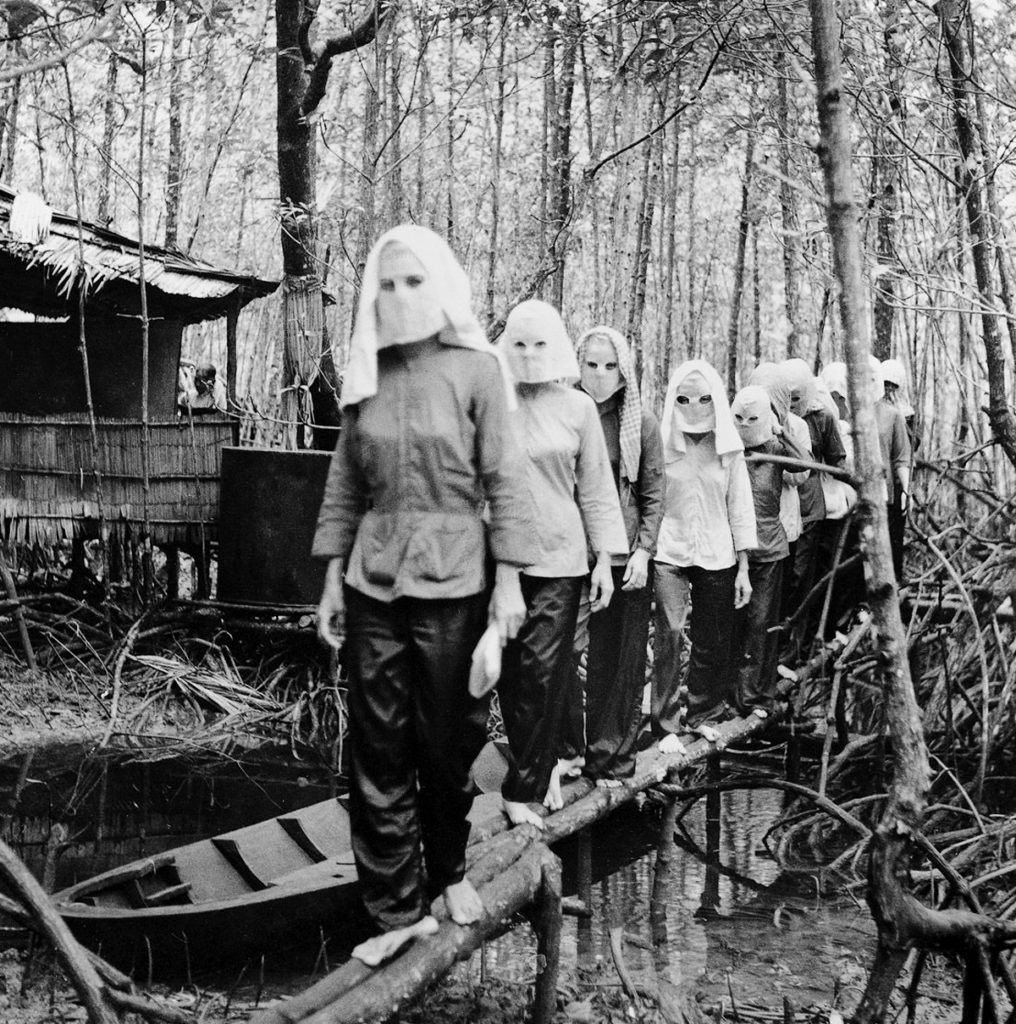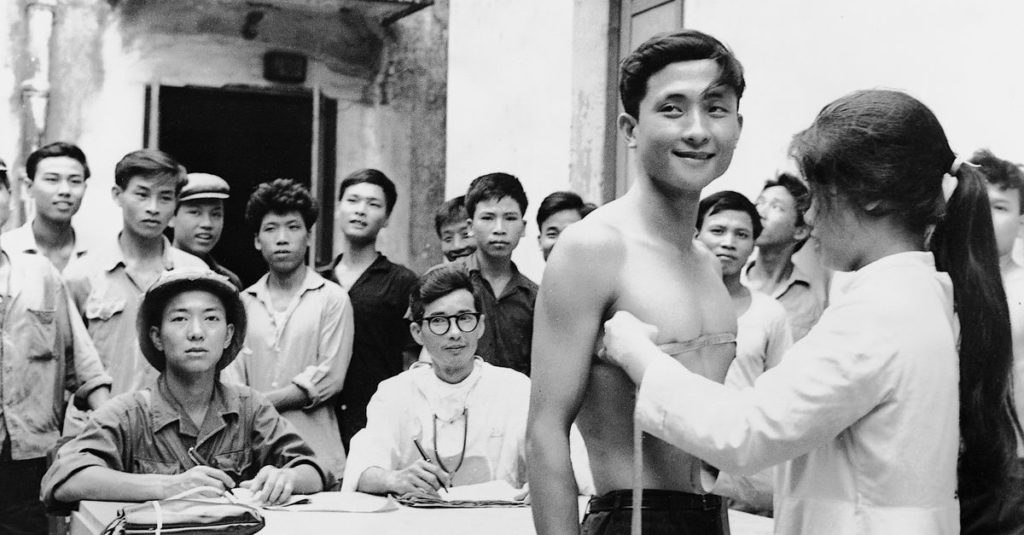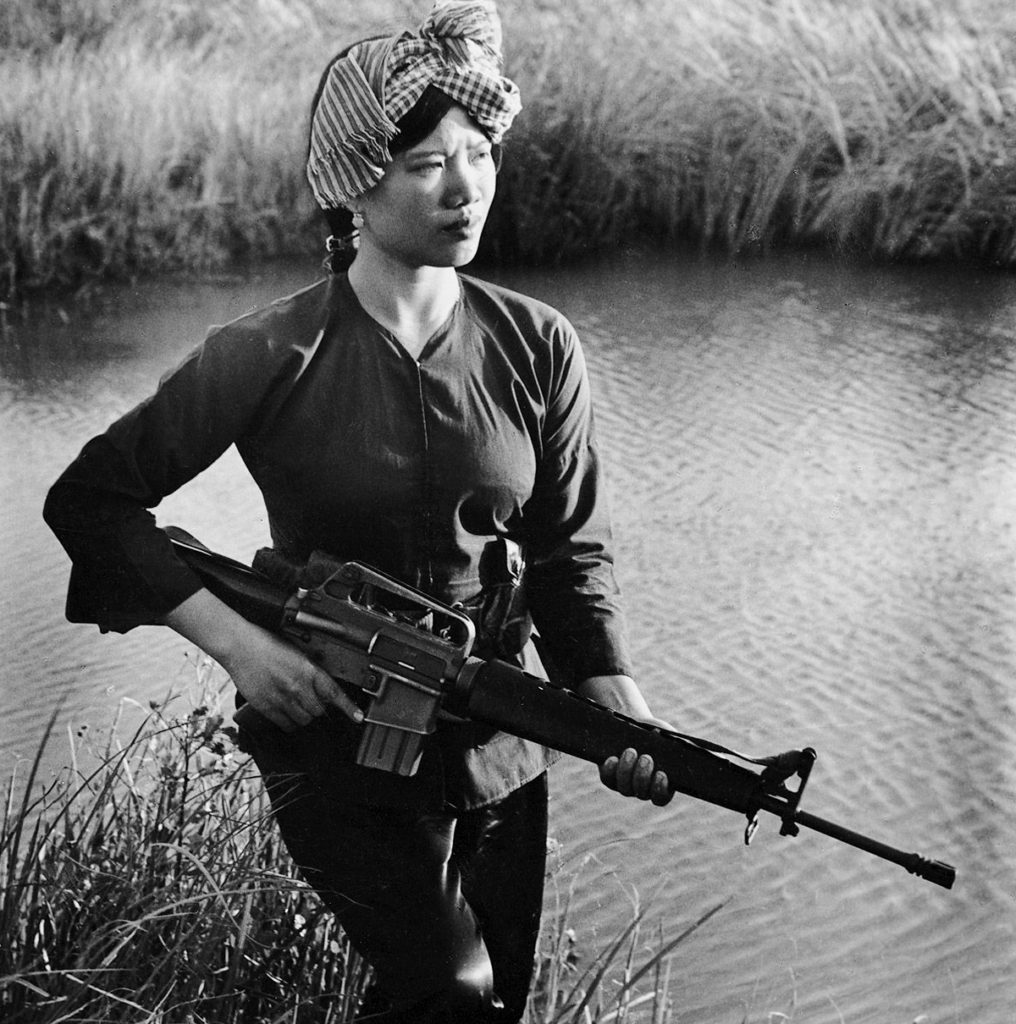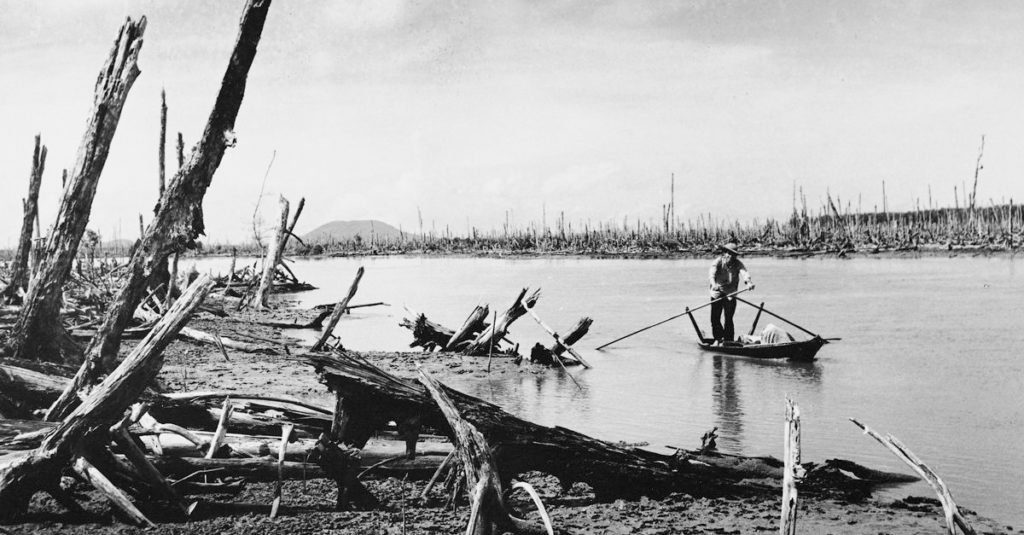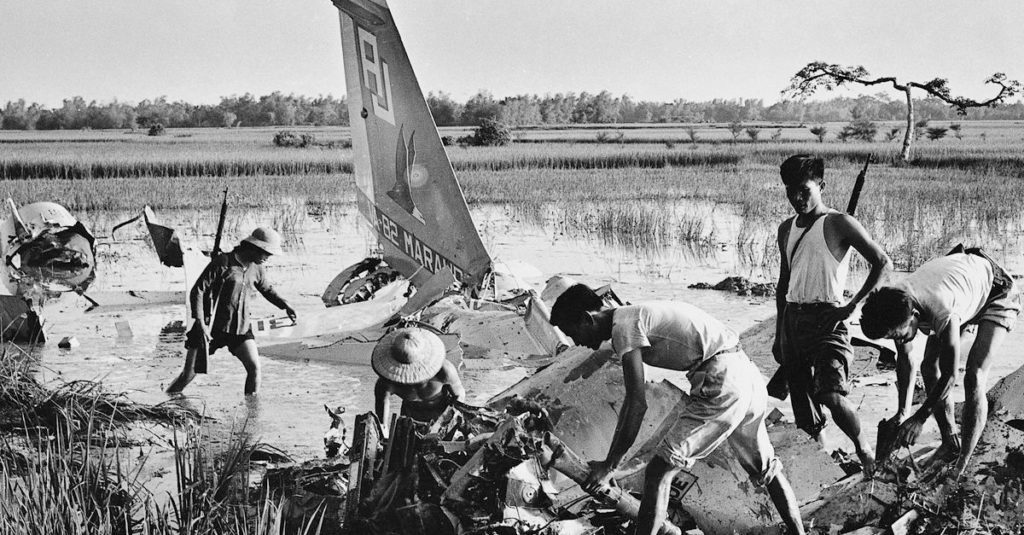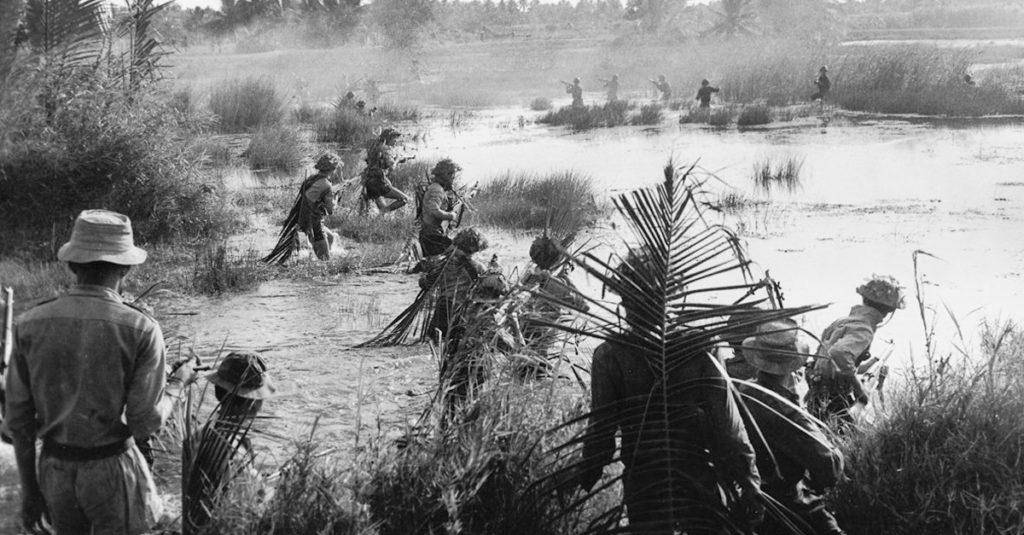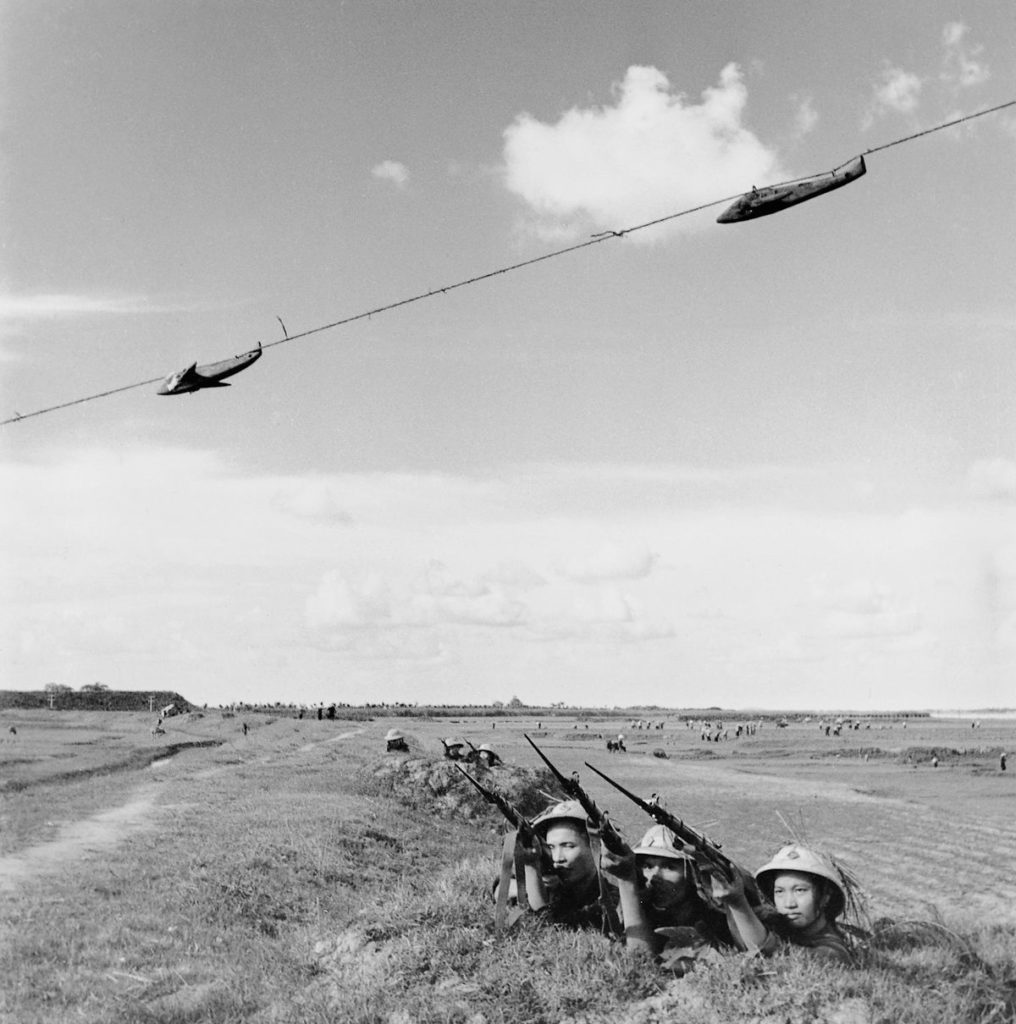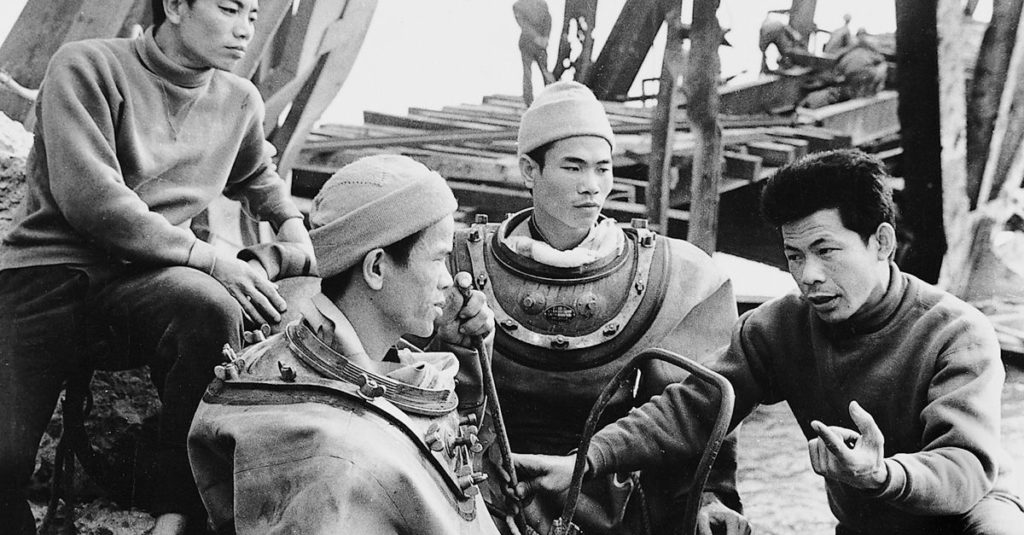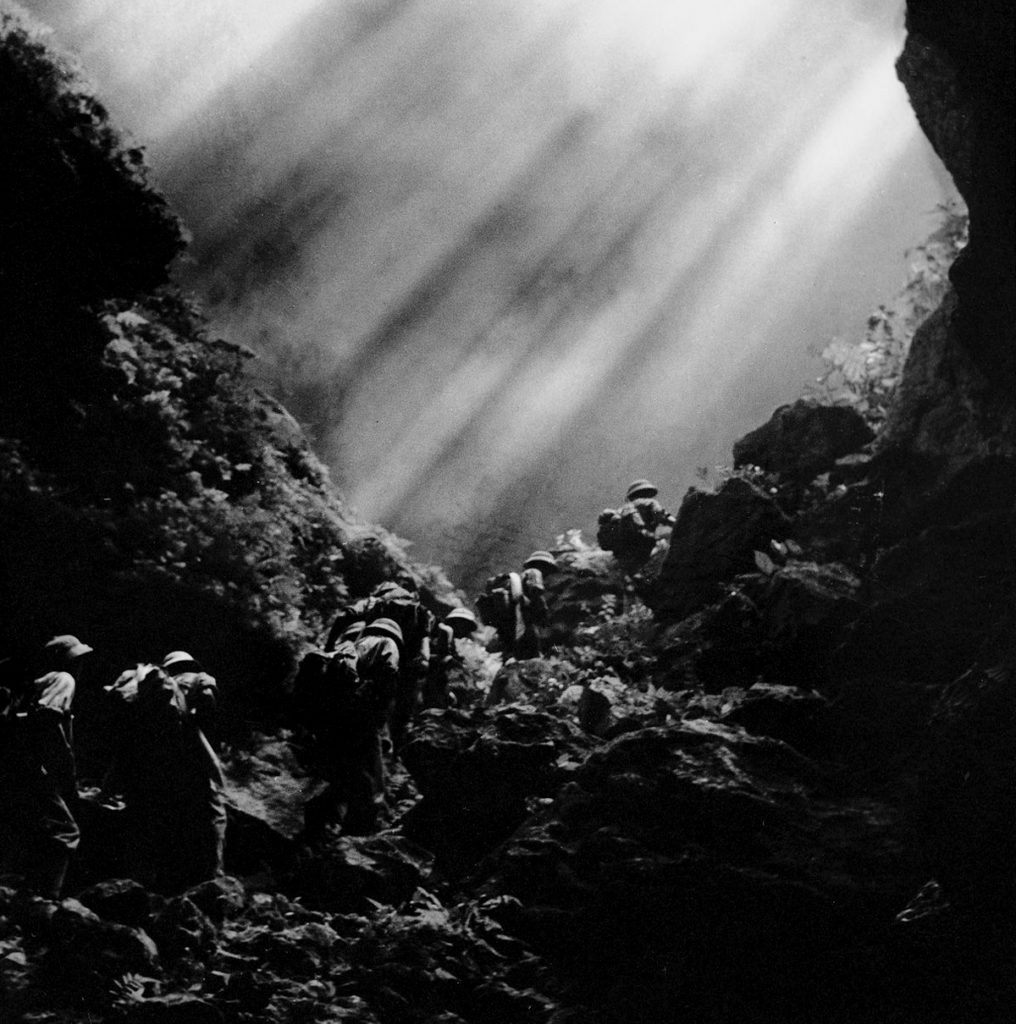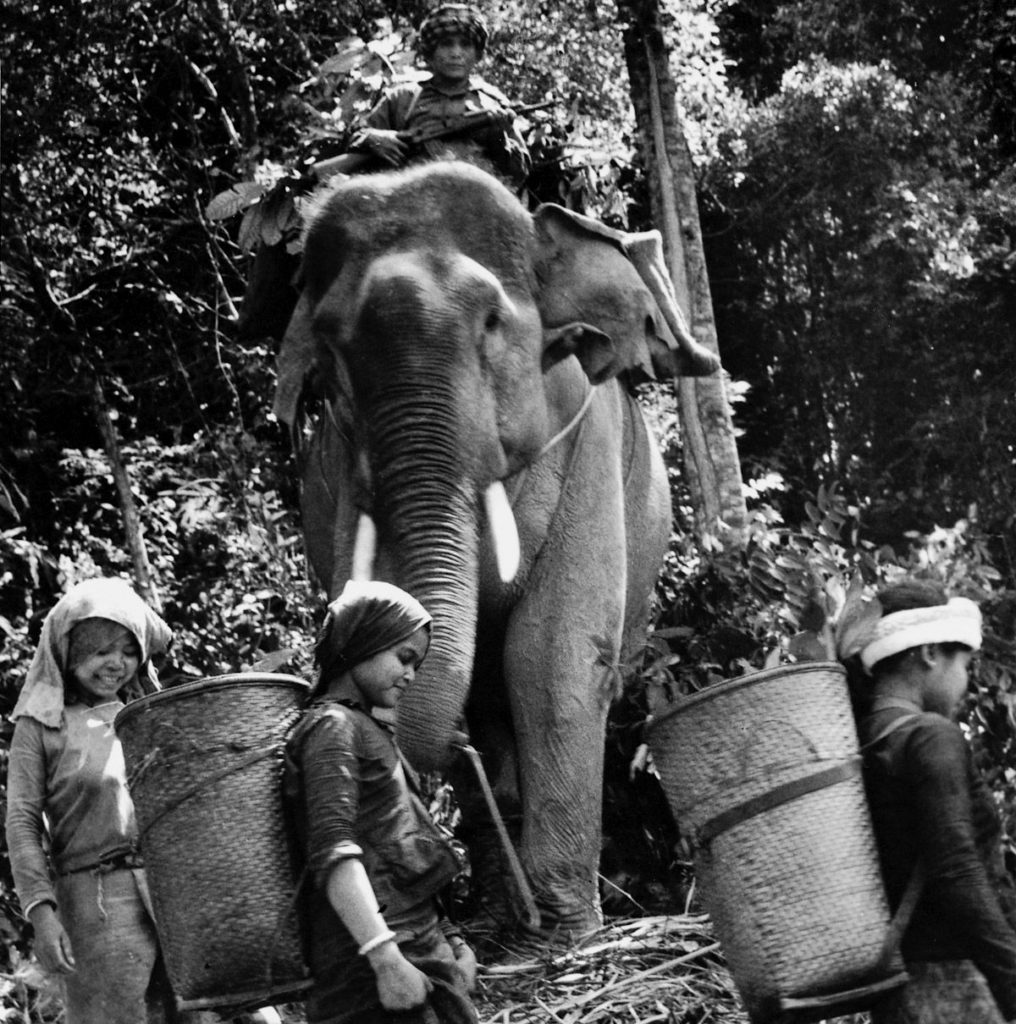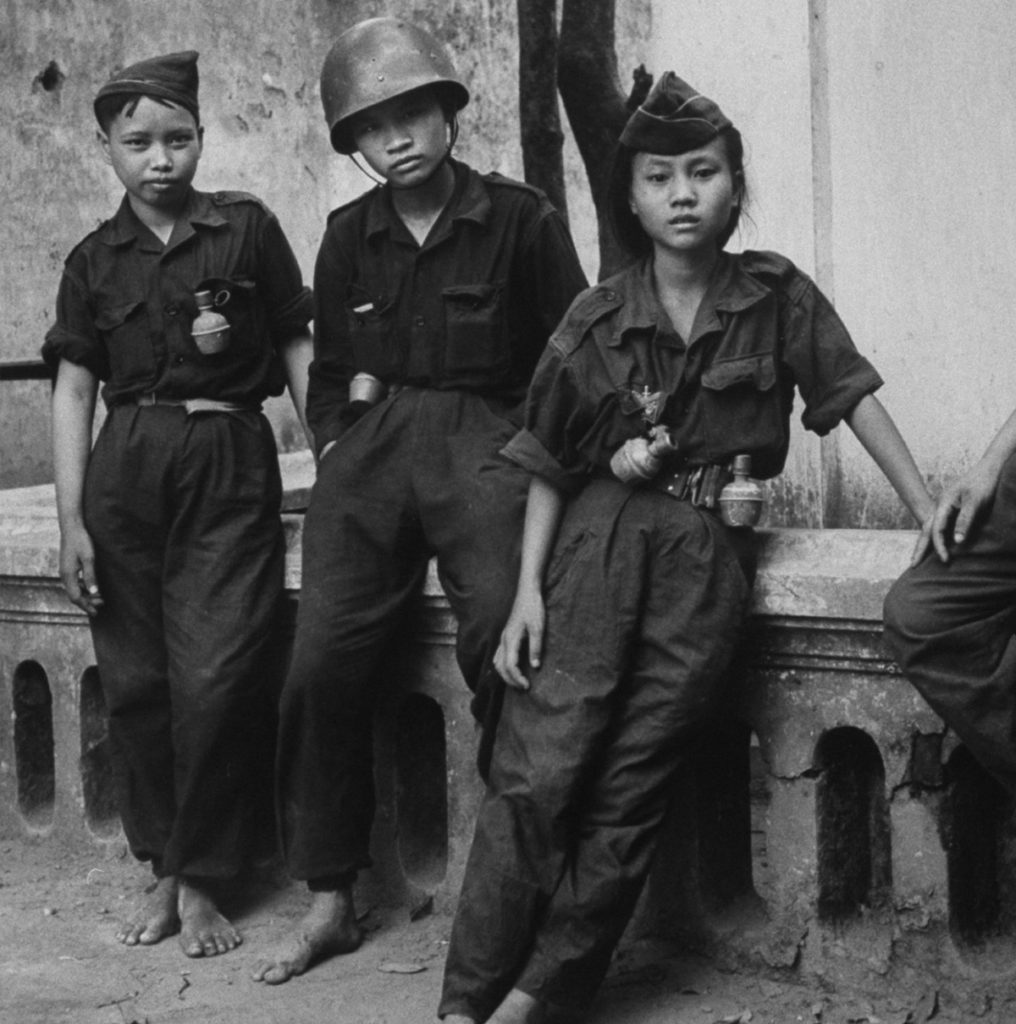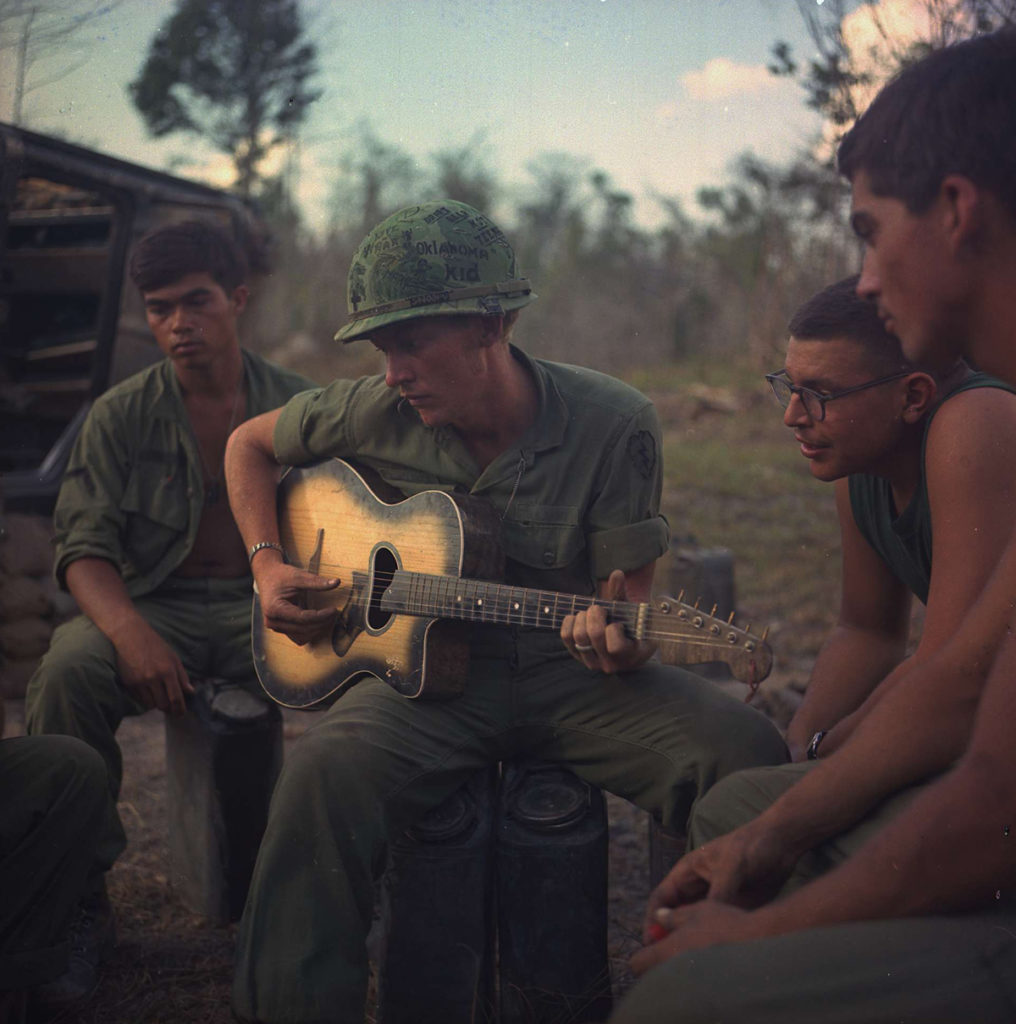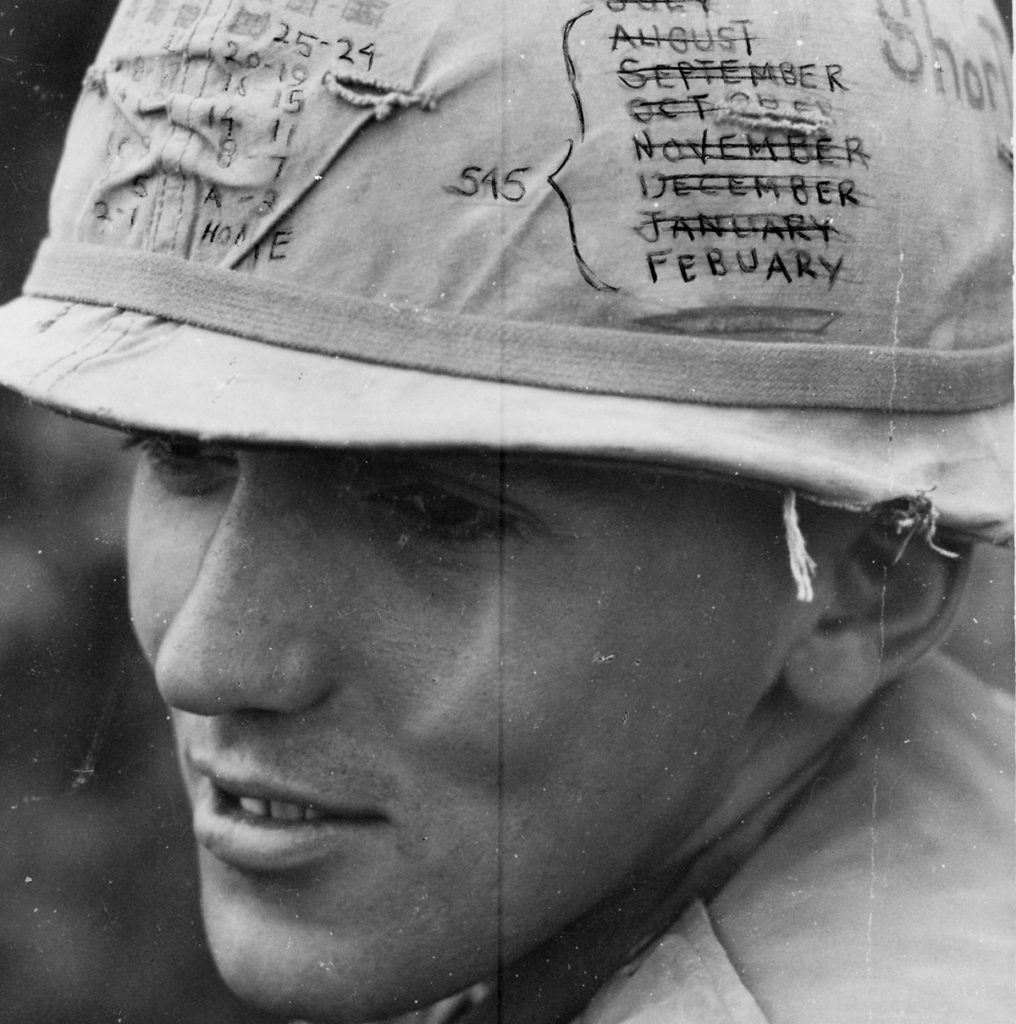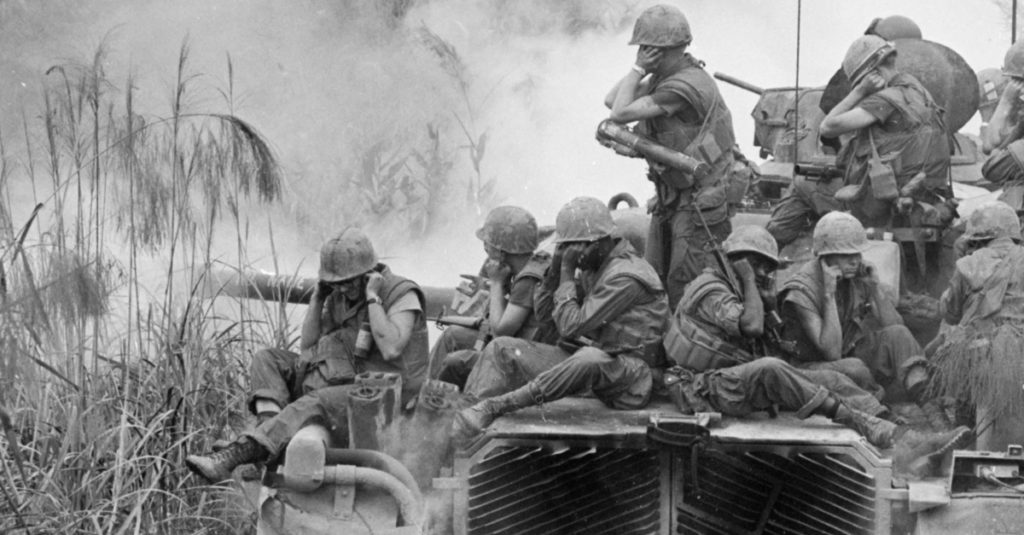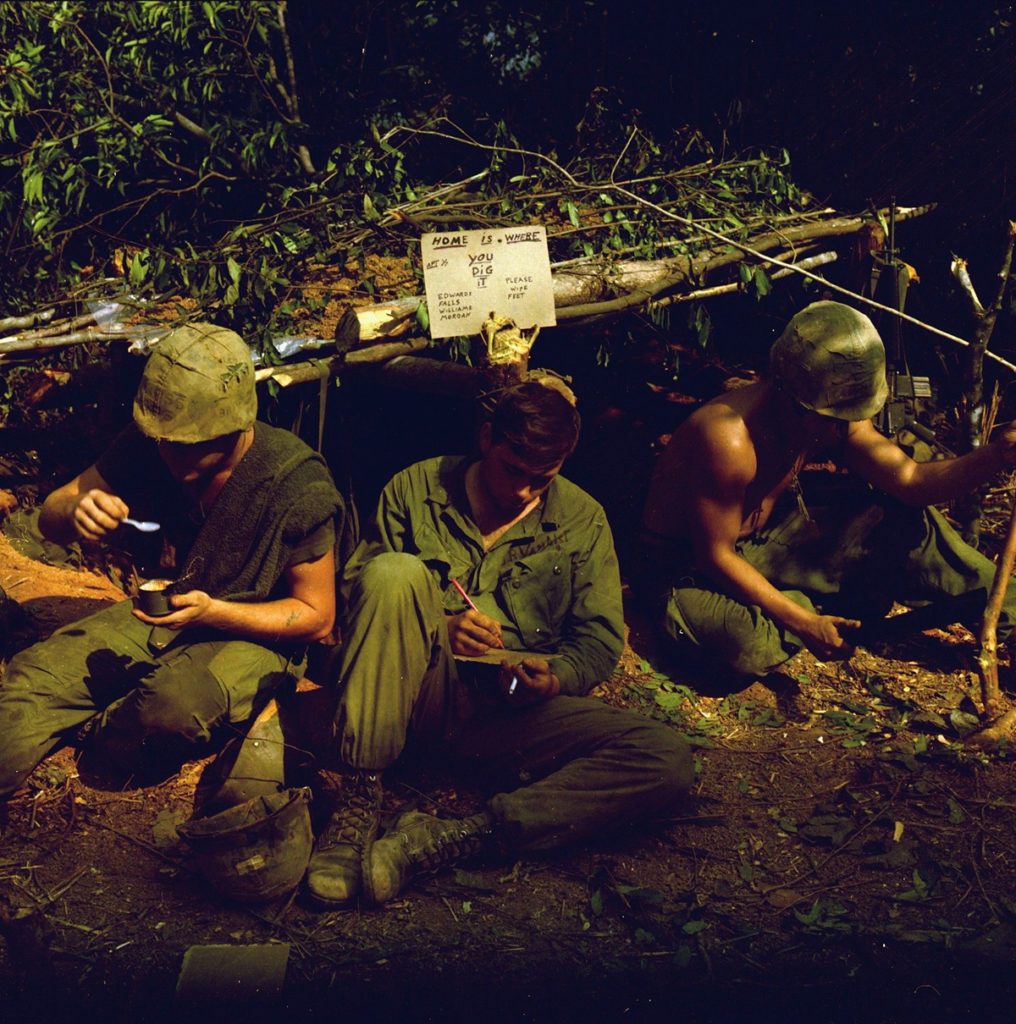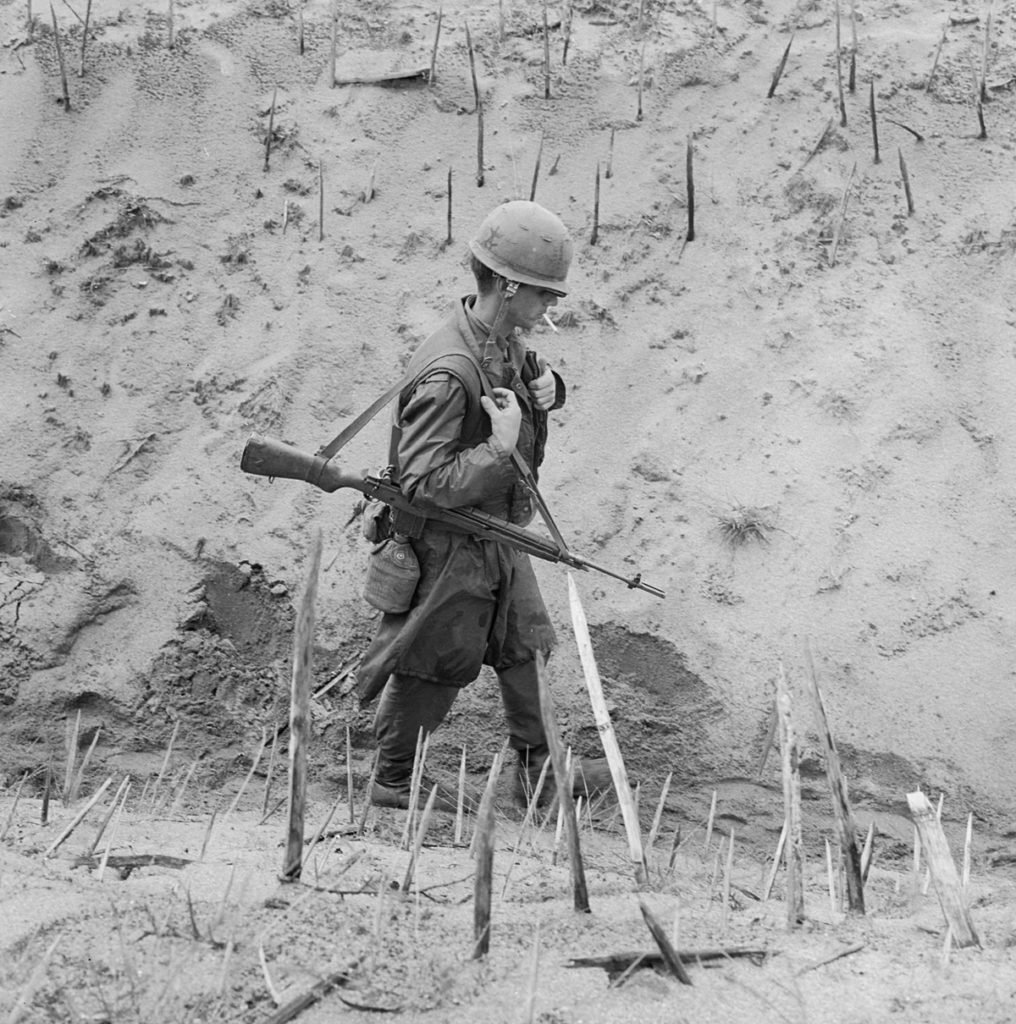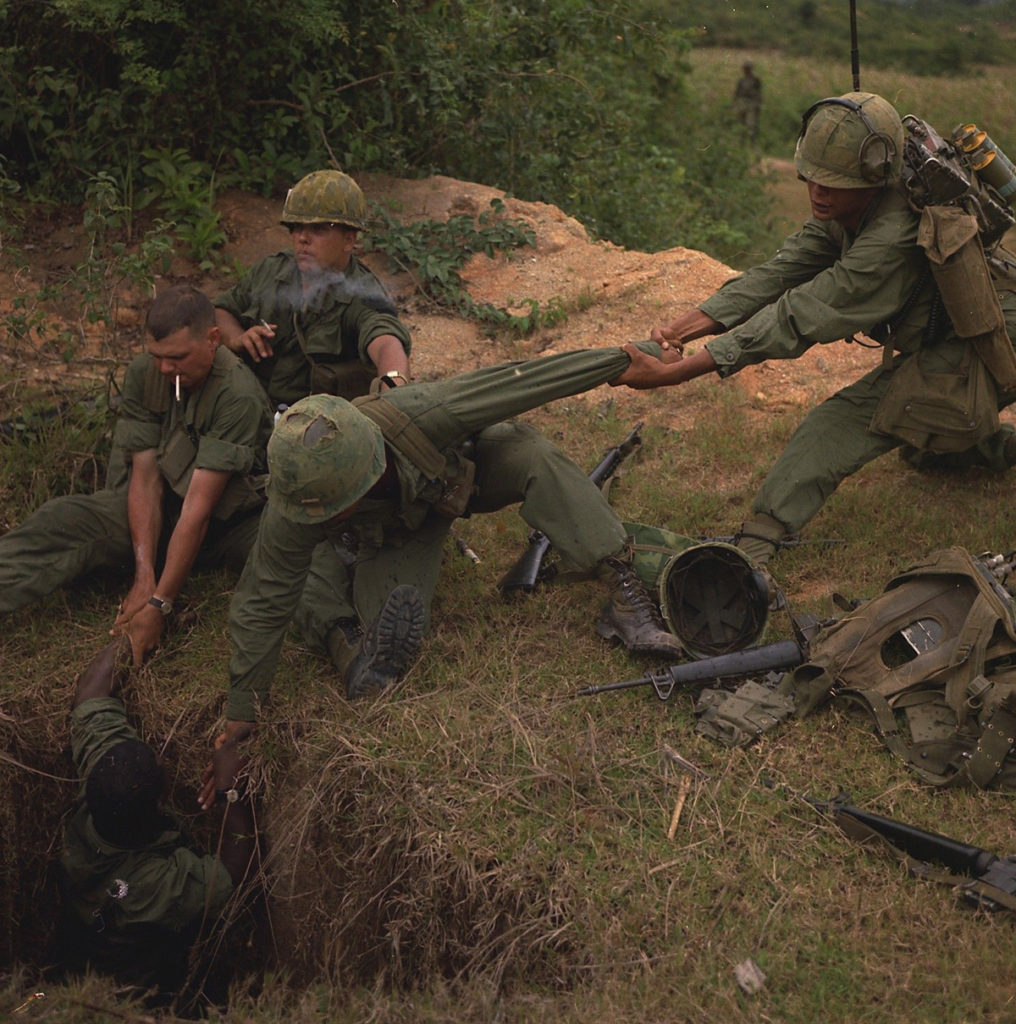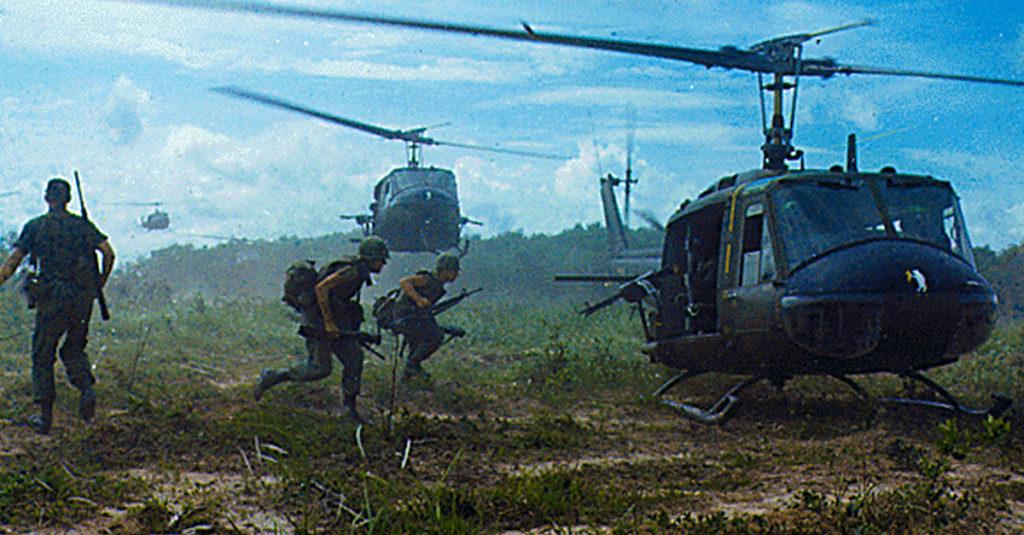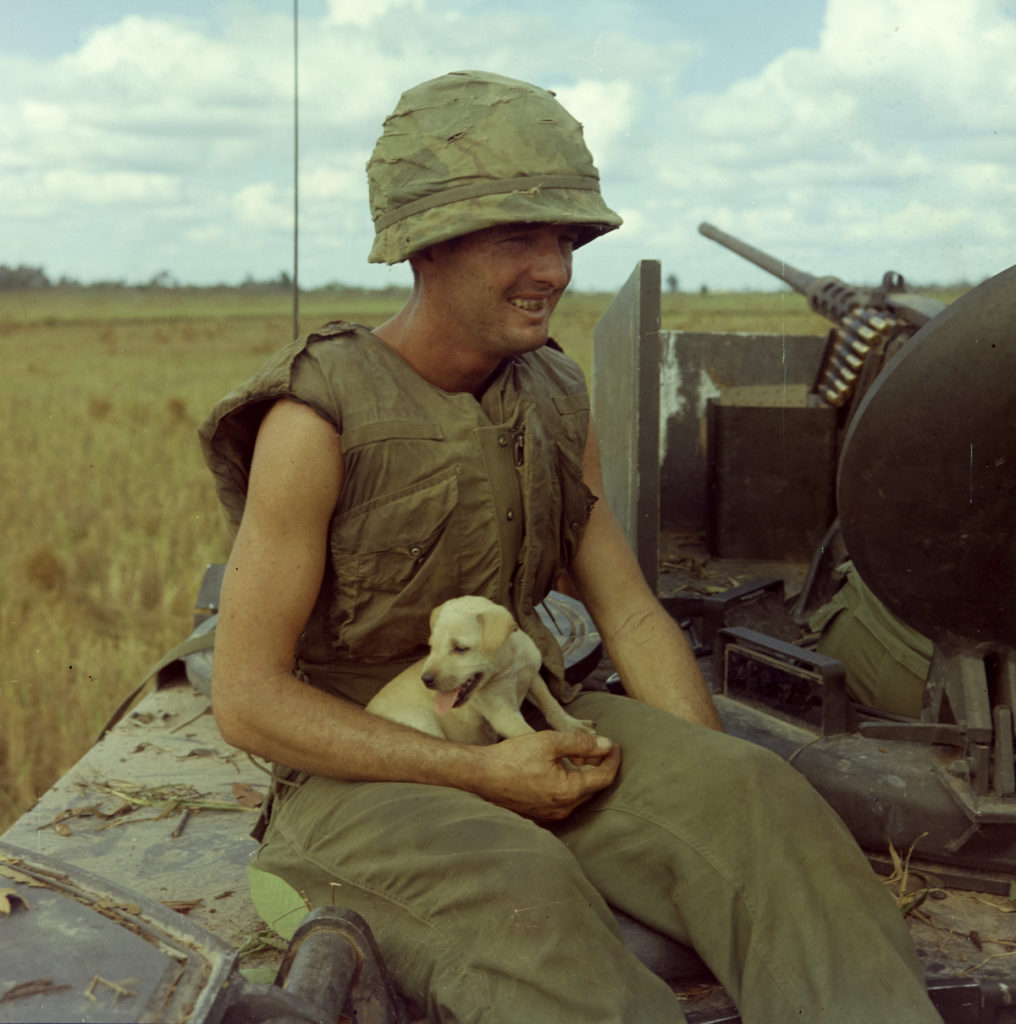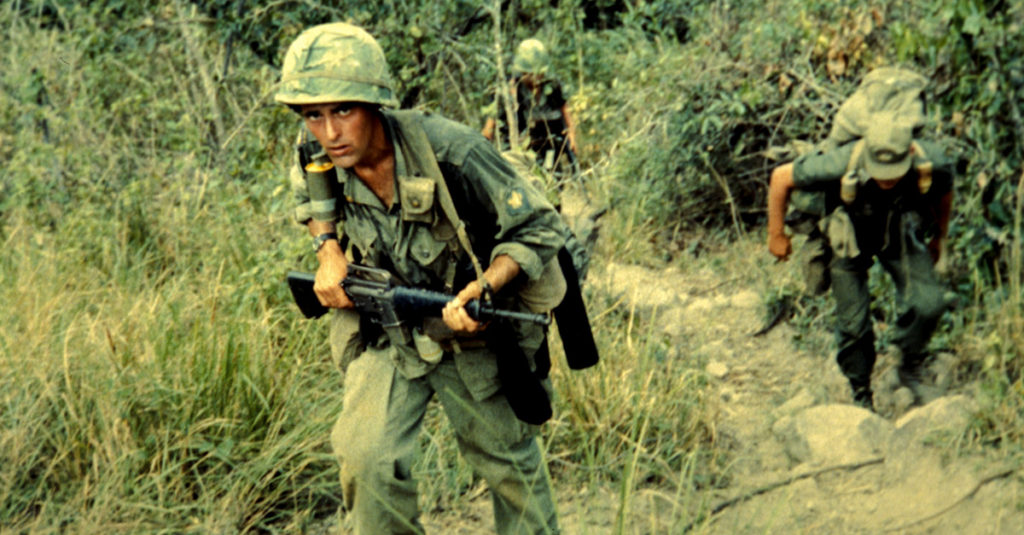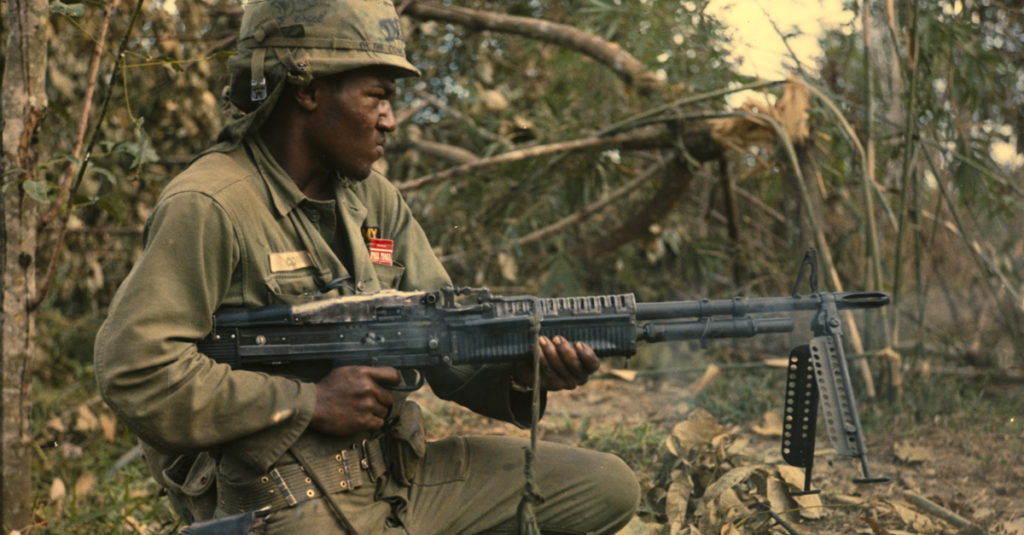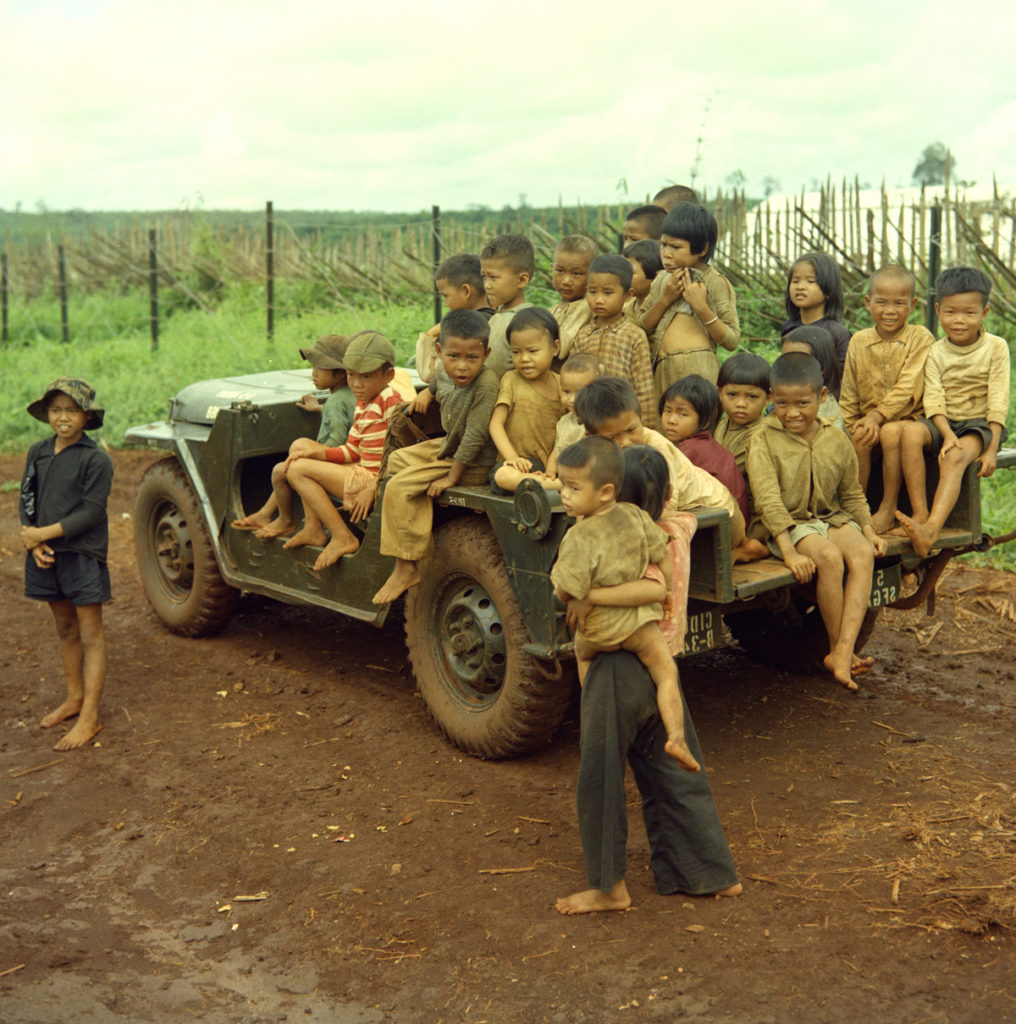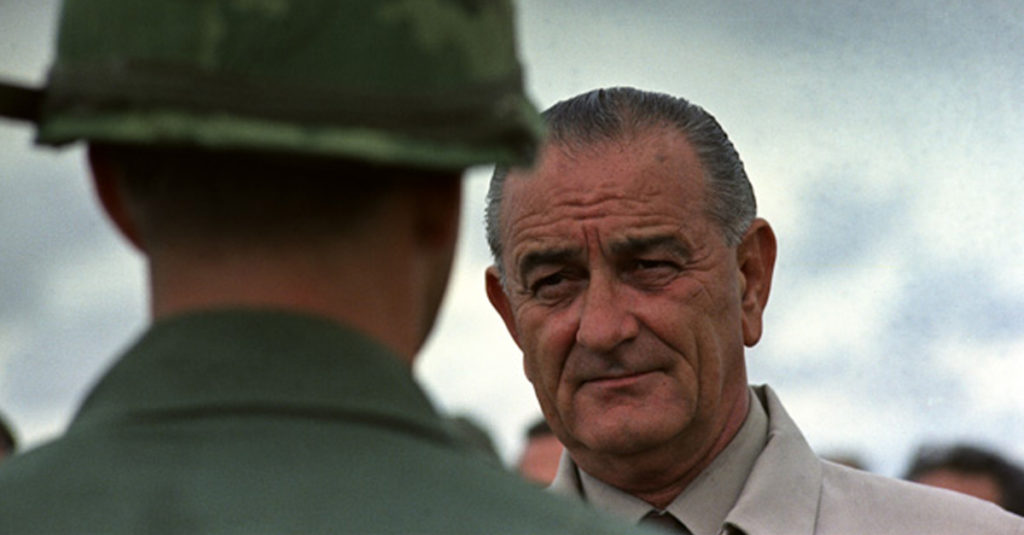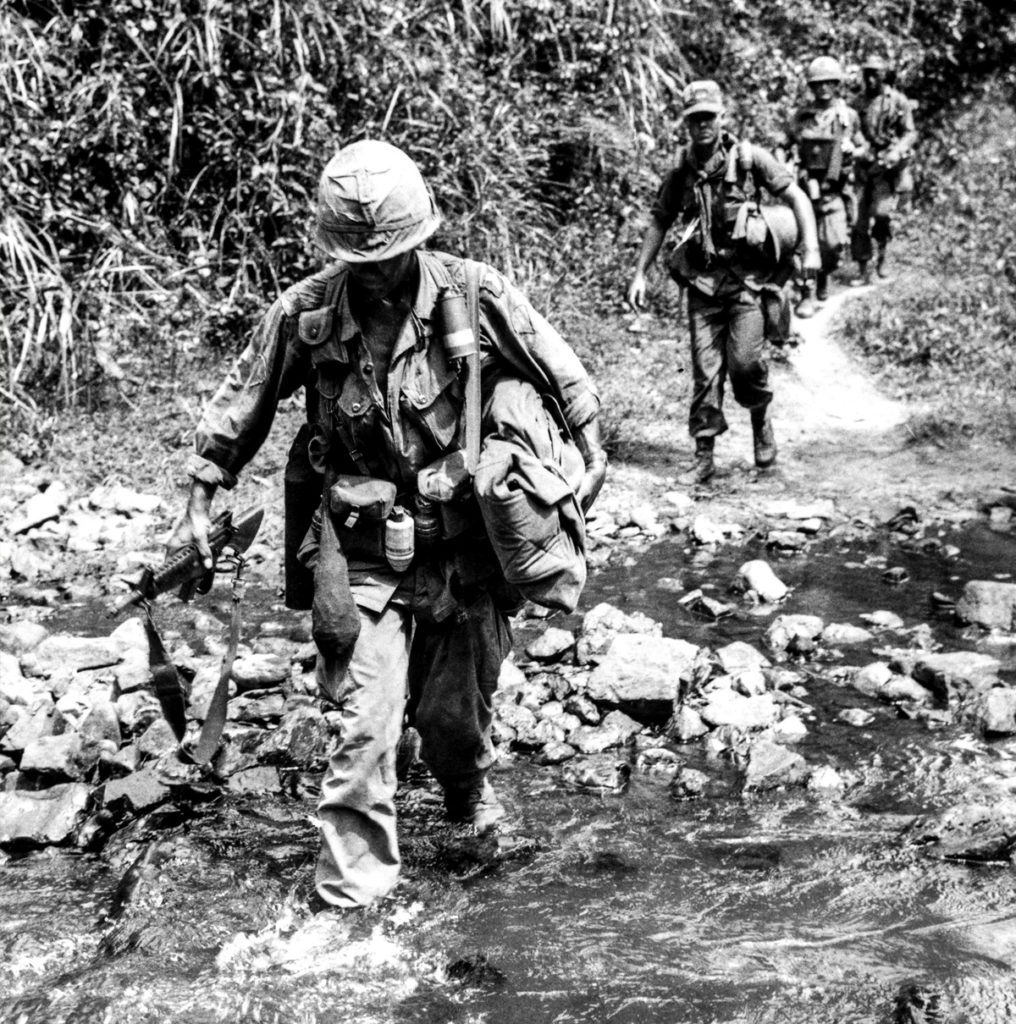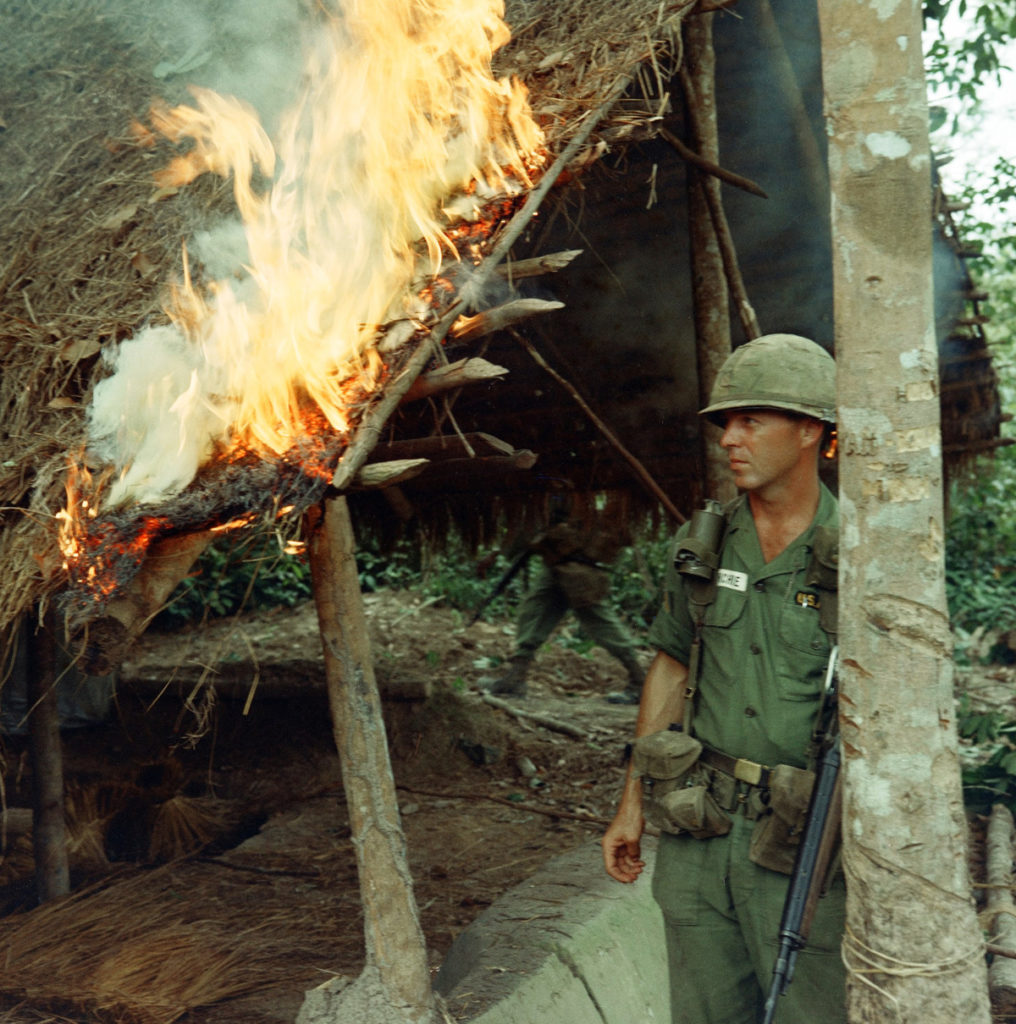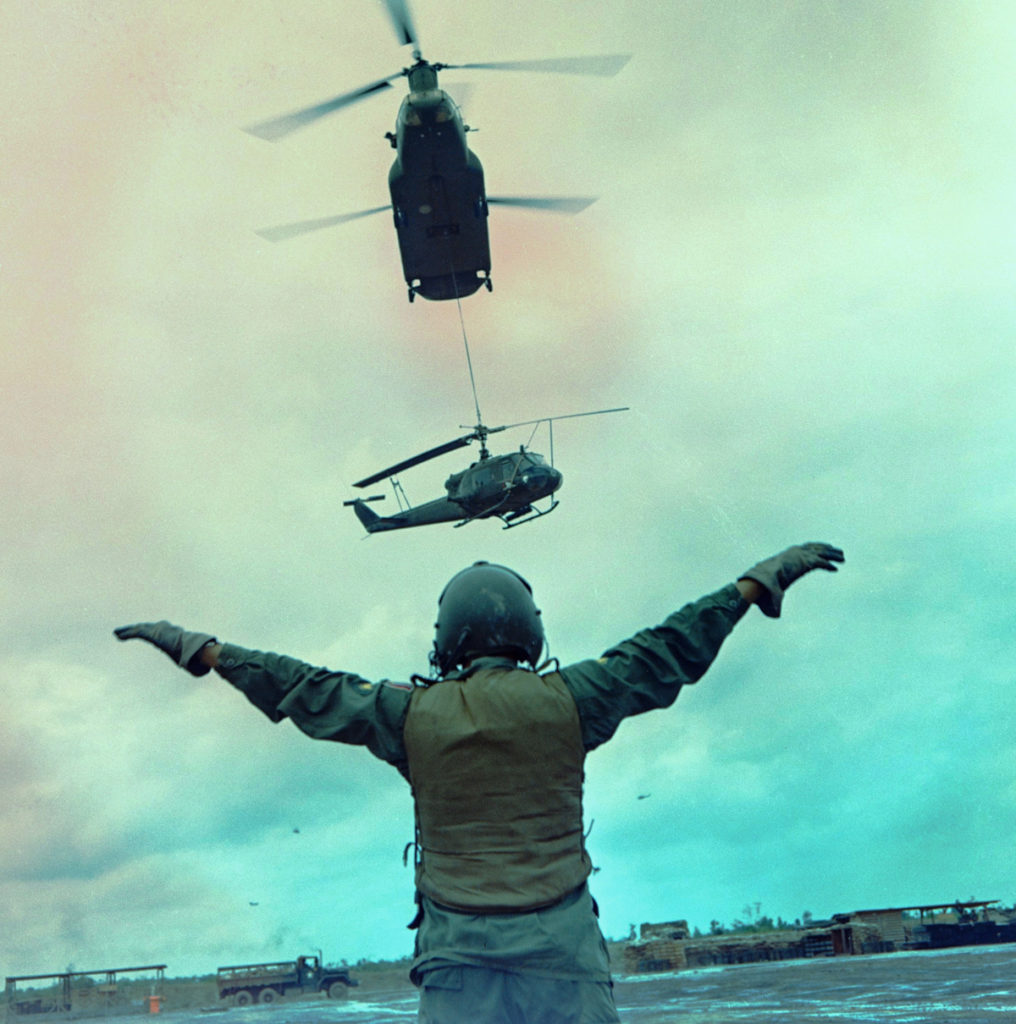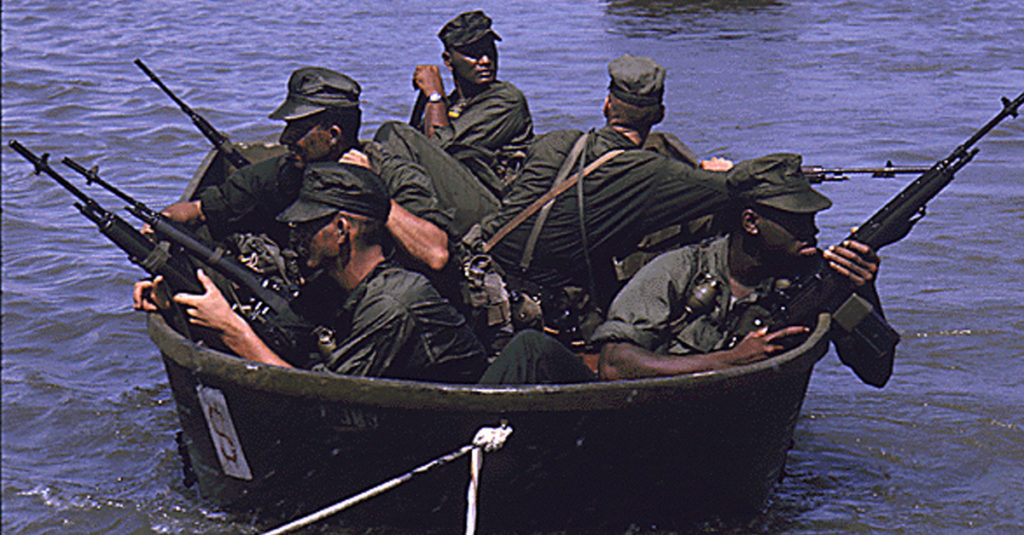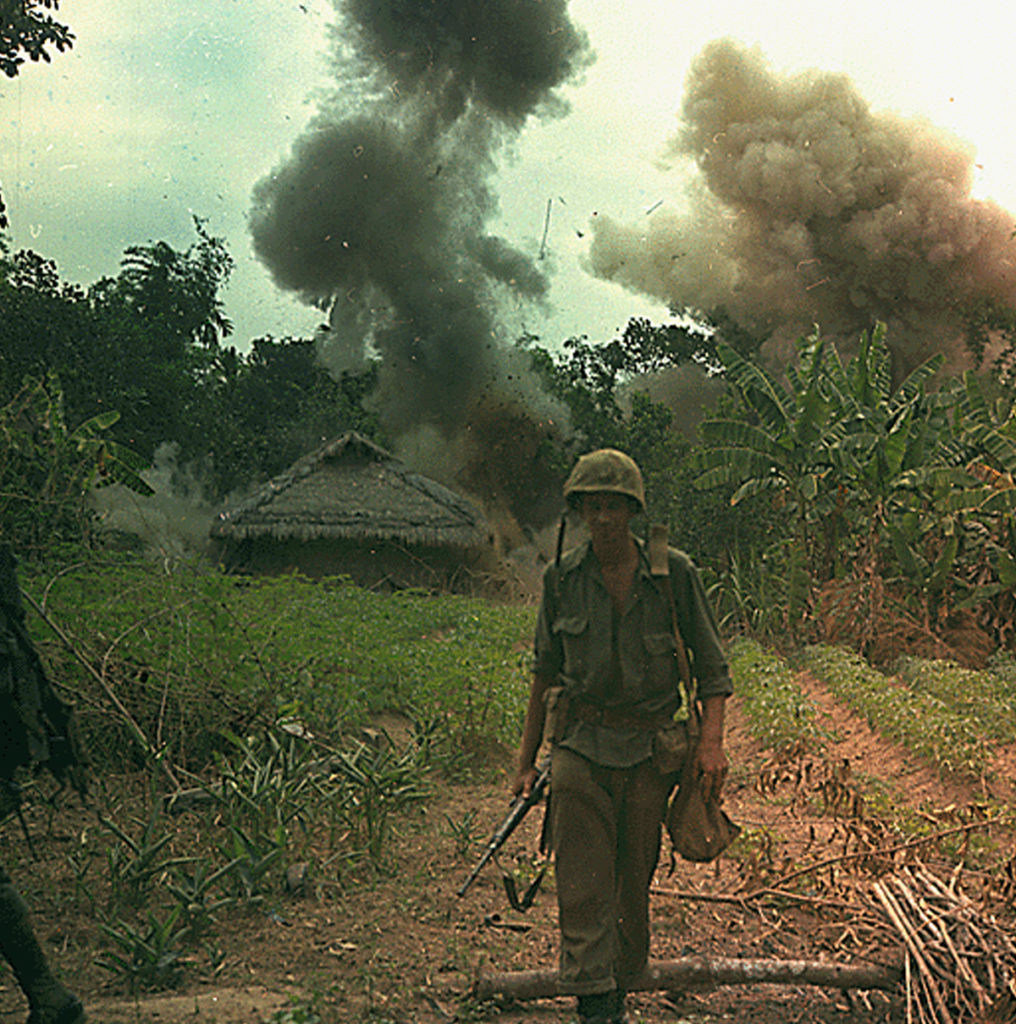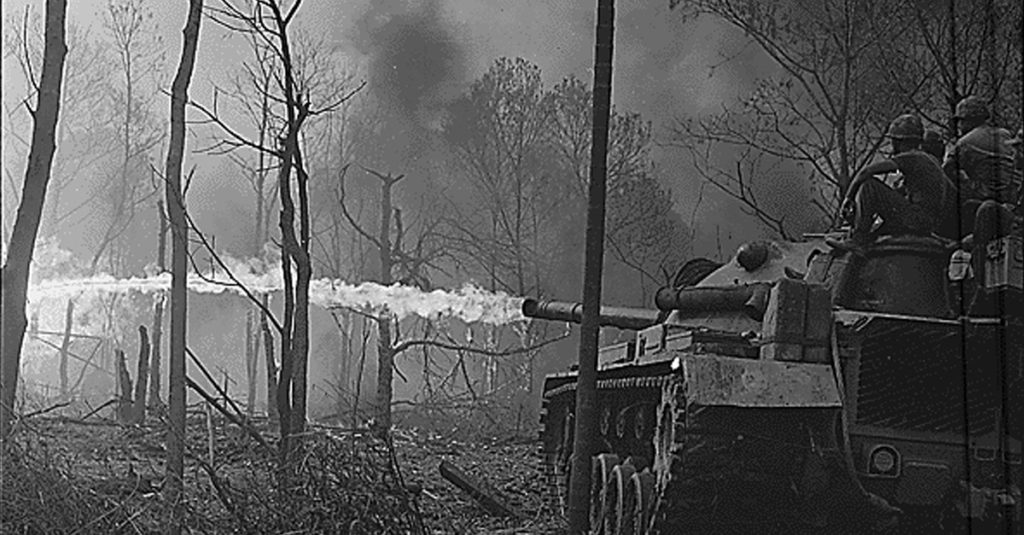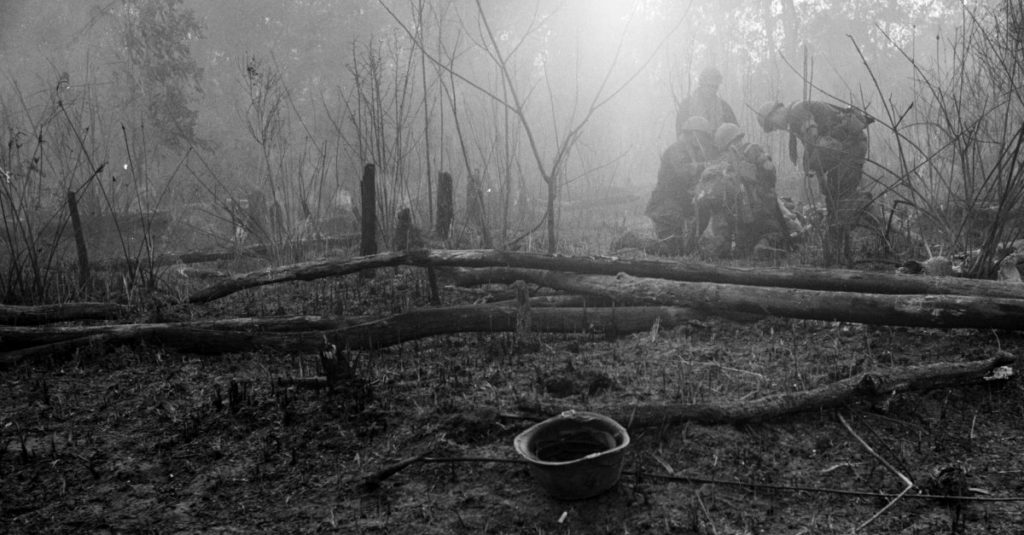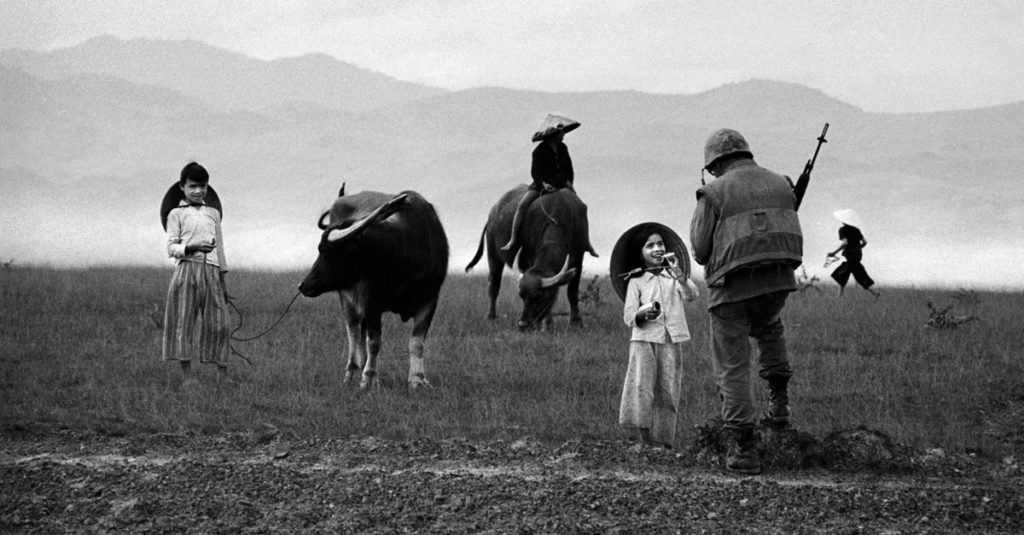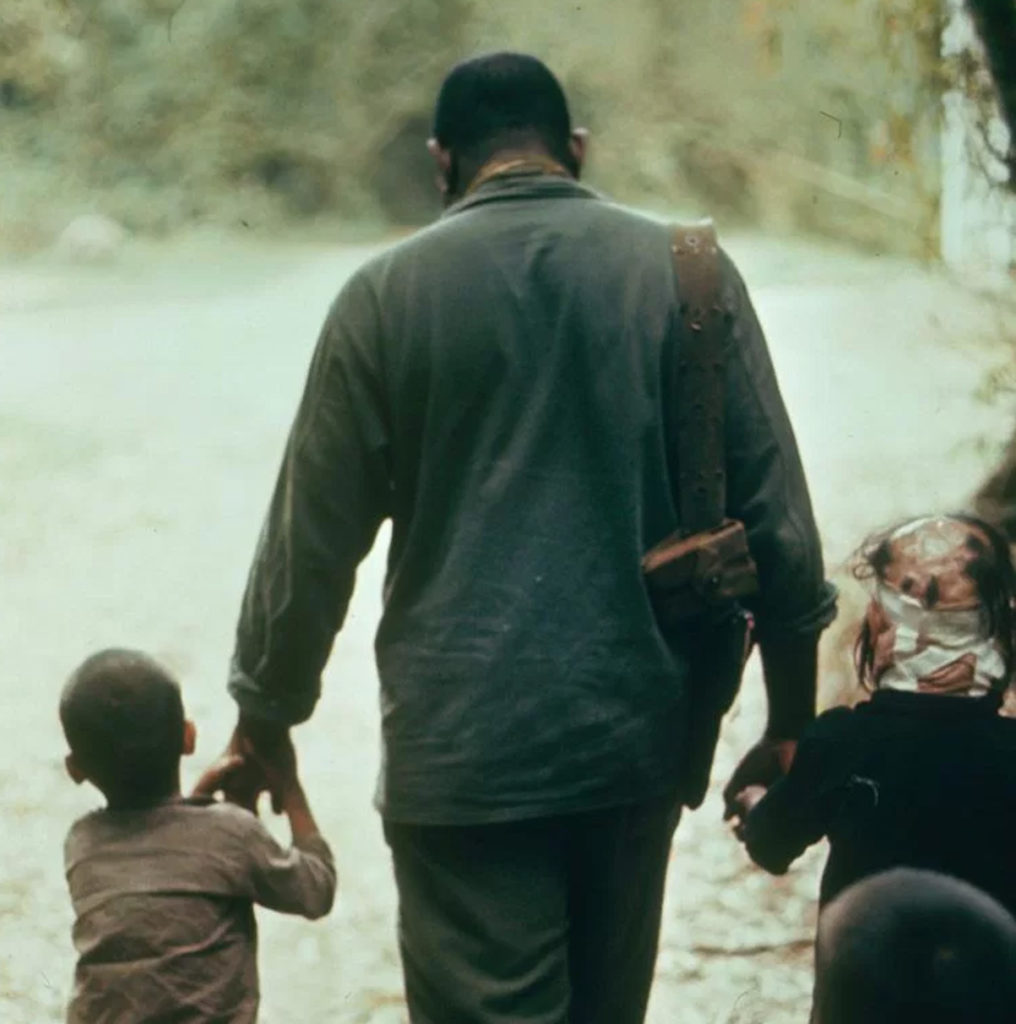#2
This young cadet is getting a physical exam. Taken in July 1967, it’s a testimony to the power of North Vietnam’s volunteer military system. It would become mandatory in 1973, yet here we see able-bodied males willingly submit to physical examination by a cute nurse in Haiphong. Even more impressive, the NVA would grow to more than half a million men by the mid 70s. The US military conceded they were one of the finest fighting forces in the entire world.
#3
This striking image from 1973 shows a female Vietcong guerilla standing guard on the Mekong Delta. As one photographer noted, you could find women like her just about anywhere during the war. This girl was just 24 years old. However, she had been widowed twice since both of her husbands were soldiers. She embodies the ideal guerrilla soldier who made extreme sacrifices for Vietnam during the war.
#4
Chemical warfare was a real threat during Vietnam, as evidenced by this 1970s photograph. The mangrove forest here has been completely defoliated by Agent Orange. United States Armed Forces would denude delta landscape with chemicals for one purpose… to deny cover for the VC. The photographer who took this particular image says he was sickened by what he snapped, since mangrove forests are regarded as a primary means of livelihood for the Vietnamese.
#5
In the mid 70s Vietnam saw women taking on men's occupations, much like the US experienced during World War II. We had Rosie the Riveter, working in factories, their ladies took up jobs like fishing. What is striking about this photo of a Vietnamese lady hauling a fishing net is this job was usually reserved exclusively for men. The image is a testimony to the human spirit.
#6
This U.S. Navy plane was shot down near the outskirts of Hanoi in September 1972. While the pilot ejected from his aircraft before impact, he was deemed MIA until March 1, 1978. That's when the US Navy secretary approved a mission to find his remains. On July 7, 1981 his remains were confirmed and subsequently return to the United States by the Vietnamese government.
#7
It's easy to forget how dangerous it was walking along the muddy banks of the Mekong Delta. Here, a Vietnamese/Cambodian border is protected by poison bamboo punji stakes. The bamboo was whittled, hardened by fire and tipped with poison. The purpose wasn't to kill, however. It was to give away the enemy’s location. Medevacs were dispatched for those sorts of things and gave away the location of US troops.
#8
What a striking image of enemies meeting face-to-face. Here, the Viet Cong and ARVN forces can be seen in full conflict on the Plain of Reeds. While the image shows both sides in combat, the Vietcong have flanked the ARVN which means the unit likely perished during this battle. Ironically enough, this image contains no date.
#9
Training was constant once the war began. As this September 1965 photo shows, soldiers practice taking shots at speeding aircraft in Thanh Tri. And while they were known for using antique World War II rifles, they were still able to down several US military aircraft. The group you see here, known as Company #6 of the Yen My Commune held the title of "Excellent Militia" for three years.
#10
Bridge repairs are being discussed in this photo from 1973. The US strategically took out transit areas for heavy trucks and machinery. The Ham Rong bridge cross the Ma River was the only route for supplies to central North Vietnam. As such it was heavily guarded by the VC. Several United States airplanes were down near this bridge, but it was ultimately destroyed.
#11
The famous Ho Chi Minh Trl. in the Truong Son mountain's never looked more eerie or creepy than it does here. Troops are tracking through the mountains which forms the 750 mile long spine of Vietnam. It stretches across most of the western border. Because of this, northern soldiers knew the trail as the Truong Son road.
#12
As the war ended, US support was withdrawn in stages. Here, you see Laotian guerillas hauling supplies by elephant to North Vietnamese Army troops in southern Laos near Route 9. This invasion, known as operation Lam Son 719, was intended to see how well the ARVN performed on their own. It was disastrous, with no US troop support, southern troops fled in panic.
#14 DON MCCULLIN
Here's an image of a U.S. Army corpsman carrying a child away from battle in Hue. The child has been injured and the photo is striking for several reasons. First, it shows the dignity of mankind and the value we place on human kindness. Second, this poor child was found by the soldier wandering between firing lines of the Americans and North Vietnamese. Most likely, his parents were killed.
#15 Howard Sochurek
It's easy to forget how young some of the soldiers were. Here, these young child Vietnamese guerillas are preparing to fight off Viet Minh forces on the Red River Delta. This image was snapped in 1954 and if you look closely, you can see the young soldiers wearing grenade belts outfitted with live grenades.
#16 Company A gathers around a guitar
Here we see soldiers taking solace after a long day of combat. Pictured here are members of Company A, 3rd Battalion, 22nd Infantry (Mechanized), 25th Infantry Division after operation Yellowstone. It was common for soldiers to unwind by gathering around a campfire or in the barracks with their brothers in arms and sing songs to forget the horrors of war.
#17 Soldier Keeping Time on His Helmet
This soldier is keeping up with the clock. You can see markings on his helmet that correspond with days and months. In short, he is simply counting down the time until his service is over. Incidentally, this happens to be a Sky Trooper from the 1st Calvary Division, Airmobile, who participated in a mission near Bong Son dubbed: Operation Pershing.
#19 A Marine Keeps a Battery Pack Dry through Mud
The marine pictured here is part of “I “Company, 3rd Battalion, 5th Marine Regiment and is on a mission 12 miles southwest of Danang Vietnam. Dry gear was important for soldiers. It ensured everything worked properly. Here you see him lifting his battery pack to keep it high and dry. Notice his buddy in the back smiling.
#20 Home is Where You Dig It
The image seen here of Private First Class Edward Private First Class Falls and Private First Class Morgan of the first Battalion, seventh Regiment Marine Company shows how humor was used to make light of horrific situations. The sun above their lean to reach home is where you dig it. We imagine this to be a very true statement considering the fact one of them is eating a can of soup with a plastic spoon. In war, you had to make do with what you had to make it through.
#21 A Marine walks through a Punji Staked Gully
Earlier, we address the danger of Pugi stakes. Here, a Marine is seen walking through a gully filled with them. So long as the stake does not pierce his boot he will be fine. However, once poison makes contact with skin, medical attention must be sought. Luckily, for this Company H Marine of the 2nd Battalion, 4th Regiment, this will not be the case.
#22 Operation Oregon Search and Destroy Mission
This mission, conducted by troop B, 1st Reconnaissance Squadron, 9th Cavalry, 1st Cavalry division air mobile platoon was harrowing. Here, you can see a servicemember lowered by members of the platoon into a tunnel 3 km west of Duc Pho, Quang Ngai Province. Search and destroy missions were always dicey.
#24
You can sometimes forget the war was fought in locations where people lived and worked. Take this scene of US soldiers from the 2nd Battalion, 14th infantry Regiment being airlifted from a rubber plantation to a new area for staging. This was Operation "Wahiawa," one of many Vietnam search and destroy missions. This one was conducted by the 25th Infantry Division northeast of Cu Chi.
#26
Being in Vietnam meant spending a lot of time in position waiting for orders. Such is the case here with Specialist 4th class McClanton Miller. This young African-American soldier is seen kneeling in dense brush simply waiting for the command to be issued for him to move forward. Patience and persistence were a constant themes of Vietnam.
#28
Snipers were a constant threat in Vietnam. Here we see the focus and attention given to their threat. Private Milton L Cook unloads his M-60 machine gun towards an area where a VC sniper was reportedly spotted. This image was taken in 1967 and is one of the color photographs of the Signal Corps Activity Archives Catalog from 1944 to 1981.
#29
Children were among the most innocent victims of the war. Here, you can see a cluster of Vietnamese children atop a special forces jeep. Often times, the US military were the only source of comfort for children whose parents fell victim to combat. The children pictured are sitting while members of a special forces group check their village to make sure living conditions are acceptable. Their village was a refugee camp located near Camp Bunard.
#30
Present Lyndon Johnson visits US Armed Forces in Cam Ranh Bay. A visit from the commander-in-chief was often times all it took to inspire morale in a war that many considered to be a lost cause. It should come as no surprise that this photograph is one of many presidential pictures preserved on file at the Lyndon Baines Johnson library in Austin, Texas.
#31
This photograph is a testament to the muddy, humid conditions that plagued soldiers during Vietnam. Here, you can see a small group of US soldiers crossing a stream near Tuy Hoa. They are searching for Viet Cong. This image is catalog as part of the series of U.S. Army operations in Vietnam from 1963 to 1973. The group of soldiers in this picture was part of Operation "Harrison."
#32
Destroying assets was thought to be a critical strategy for winning the Vietnam war. Here, you can see a US soldier setting fire to a rice storage building. It was formerly used by Vietcong troops for various purposes. Most likely, it was a means of shelter, but also could have been used to store supplies or warehouse ammunition.
#33
Just as all of the military equipment and vehicles had to be airlifted into Vietnam, they also had to be extricated. Here, we see an EVAC situation where a UH1C gunship is being airlifted to safety. Notice the air traffic controller making sure everything goes as planned. Teamwork and training were necessary in order for war objectives to be achieved.
#34
This is probably one of the most striking images from the war. Thirty five miles from Saigon, a group of US Marines were called upon to make an amphibious assault in the Rung Sat Zone. Grouped in fours and fives, they were outfitted with small motor boats to assault the Vietcong. The area was infested. As a result, operation Jackstay, involved about 1,200 Marines.
#39 Philip Jones Griffiths
Here we see American GIs giving out candy. Many people who survived Vietnam now tell stories of being wary of such things. After all, candy was a very special thing so anyone giving it away was suspect. Allies were known for showing generosity when they landed by giving locals items like nylons, cigarettes and candy. It was a way to extend trust, but could take a while before it was effective.
#40 Philip Jones Griffiths
This is perhaps the most striking image of the war. Here you see enemies cradling each other. Often times, American soldiers were compassionate toward the Viet Cong. They admired the dedication and bravery required for young Vietnamese men to go to war for their beliefs. This particular VC continued to fight for three full days while his intestines were tucked inside a cooking bowl strapped to his stomach. The American soldiers are offering support and comfort during his final moments.
